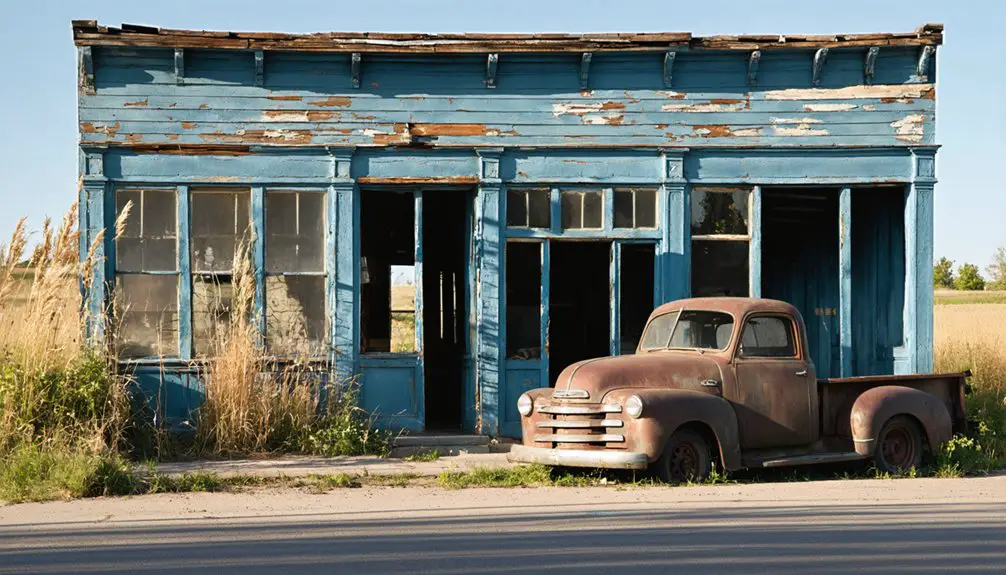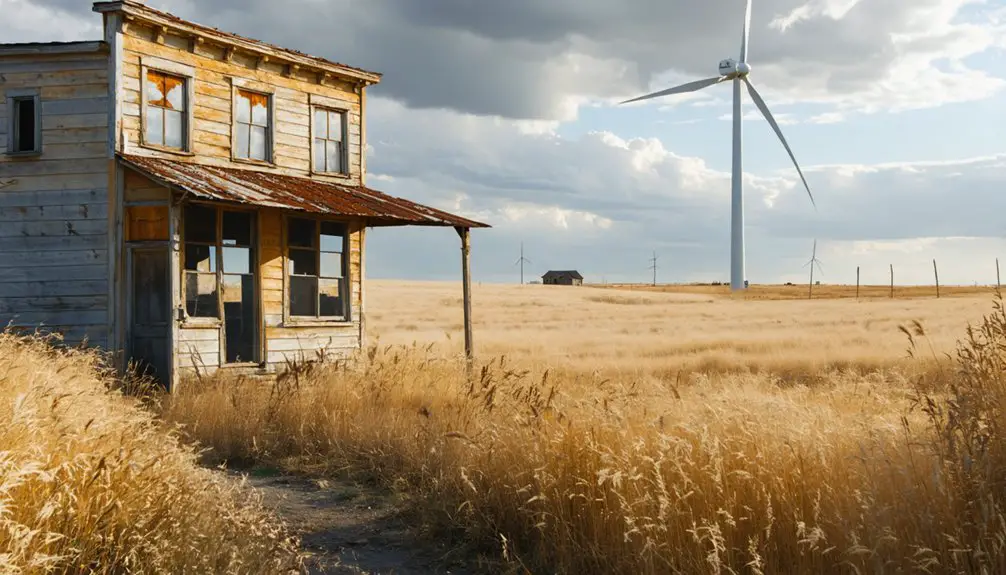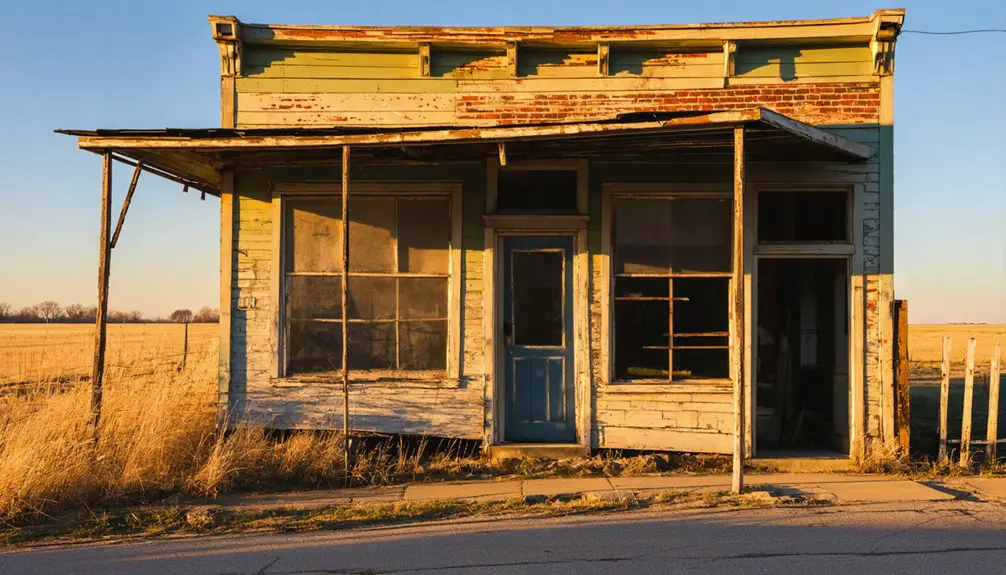You’ll find Padonia’s ghost town origins in Brown County, Kansas, where E.R. Cornelison established the settlement in 1854. The town flourished through its water-powered mill, producing 30 barrels of flour daily, and gained prominence with Welsh settlers arriving in 1869. While the Missouri Pacific Railroad initially boosted growth, declining agricultural profits and population loss transformed this once-thriving community. The remnants of Padonia’s past still whisper stories through its scattered farmhouses and rural landscape.
Key Takeaways
- Padonia, Kansas, established in 1854, transitioned from a thriving agricultural settlement to a ghost town due to economic decline and population exodus.
- The town’s prominent water-powered mill, producing 30 barrels of flour daily, ceased operations when petroleum power became dominant.
- Population decreased to 175 residents by 2025, with aging demographics and limited job prospects driving continued outmigration.
- Only scattered farmhouses and agricultural buildings remain today, with the original townsite largely returned to farmland averaging 140 acres.
- The Walnut River, which once powered the town’s industrial growth, now flows through a rural landscape of corn, soybean, and wheat fields.
The First Settlers and Welsh Heritage
While many frontier towns in Kansas sprang up gradually, Padonia’s establishment can be traced to a precise date when E. R. Cornelison claimed his land on April 3, 1854.
The settler stories that followed included John Schmidt, who built a sawmill on the Walnut River in 1856, and Jessie Padon, whose name would become synonymous with the town itself.
The establishment of the first post office in 1857 marked a significant milestone in the town’s development.
You’ll find that Welsh traditions became deeply woven into Padonia’s fabric when David Evans led several Welsh families to the area in 1869.
These ten Welsh families, known for their farming prowess, formed the backbone of the “Welsch Settlement” in Padonia Township.
Their influence extended beyond agriculture, as they brought their distinctive culture and language, establishing a Welsh community that would shape the town’s character for generations to come.
Establishing Roots in Brown County
As Padonia Township took shape in 1869 under David Evans’s leadership, it quickly established itself as a prominent agricultural settlement in Brown County, spanning over forty-one square miles of rich, partially wooded terrain.
You’ll find that settlement patterns centered around farmhouses rather than urban clusters, creating what locals called a “thick settlement” just six miles north of Hiawatha.
The community dynamics were shaped by the Padonia Town Company, which built essential structures like the schoolhouse in 1858. While the Missouri Pacific Railroad station provided connections to wider markets by the 1880s, Padonia maintained its rural character. The township established one of the county’s first post offices in 1857, serving the growing community of settlers.
The township’s economy thrived on agriculture, with water-powered sawmills and flouring mills along Walnut River supporting the farming community’s needs.
Water-Powered Industry and Economic Growth
The water-powered mill in Padonia stood as Brown County’s sole hydro-powered operation, marking a significant industrial achievement for the township.
With its two 20-inch wheels and three runs of buhrs, you’d find this powerhouse churning out up to 30 barrels of flour daily, supplying essential resources across the region.
The mill’s economic impact rippled through the community in three key ways:
- Created a critical processing hub for local farmers
- Established trade networks reaching Hiawatha, Hamlin, and even Nebraska
- Sparked related commerce and settlement growth along Walnut Creek
When Samuel Danes took ownership in 1876, he modernized the machinery, boosting production capabilities.
Yet, like many water-powered mills across Kansas, Padonia’s operation eventually succumbed to the rise of cheaper fossil fuel alternatives. As Kansas transitioned to petroleum power, operations like Padonia’s mill were outpaced by the oil refining industry, which processed 25 barrels of crude oil per day in its first refinery at Paola in 1886.
Life Along the Missouri Pacific Railroad
During the late 19th century, life in Padonia transformed dramatically after the Missouri Pacific Railroad established its presence in the region.
You’d find yourself at the crossroads of a major railroad expansion that connected communities across the Midwest and Southwest. The Missouri Pacific’s standard gauge tracks, converted from their original 5 feet 6 inches width in 1869, opened up unprecedented opportunities for trade and travel.
As part of Jay Gould’s growing southwestern system, the railroad brought enhanced community connectivity to towns like Padonia. Construction of the Missouri Pacific began in 1851 with operations and steadily expanded westward. Under the leadership of Jay Gould in 1879, the railroad underwent significant expansion and consolidation of smaller rail lines.
You could ship your goods to major markets in St. Louis, Kansas City, and Omaha, while passenger services made travel more accessible than ever before. The railroad’s presence meant you weren’t just living in a small Kansas town – you were part of an integrated regional economy.
Civil War Era Impact and Local Tensions
While the railroad would later shape Padonia’s destiny, earlier tensions from the Civil War era left an indelible mark on the community’s foundation.
You’ll find that Brown County, including Padonia, stood at the heart of intense local tensions, with residents divided between Pro-Slavery and Free State sympathies.
The Civil War’s impact on Padonia manifested in three significant ways:
- The bloodless “Battle of Padonia” in 1861, when 100 Missouri guerrilla fighters targeted the strategic border town
- The establishment of a strong Welsh Settlement that reinforced Free State ideology and community stability
- The area’s connection to African American military units, including the 1st Kansas Colored Infantry Regiment, which helped secure Kansas’s entry as a free state
The community’s position along the Kansas-Missouri border made it an essential point in the region’s struggle for freedom. The area’s history was particularly shaped by attorney Isaac Newton Smith, who served in the Mexican War and whose sons later fought in the Civil War conflict.
Agricultural Legacy and Township Development
Founded in pioneering spirit, Padonia’s agricultural legacy began with E.R. Cornelison’s 1854 land claim.
You’ll find the township’s rich history shaped by Welsh immigrants who introduced advanced farming techniques, including specialized livestock breeding with Southdown and Cotswold sheep.
Agricultural innovations flourished as the community established essential infrastructure. The 1856 sawmill and 1876 Padonia Flouring Mills, powered by twin 20-inch water wheels, demonstrated the township’s industrial progress. The Danes-operated mill produced thirty barrels of flour daily.
You’ll discover how the Jones cheese factory, producing 200 pounds annually per cow, exemplified agricultural diversification. The farmer-owned grain elevator and Missouri Pacific Railroad station integrated Padonia’s products into regional markets.
While never becoming an urban center, Padonia’s 41-square-mile expanse of farmland, dotted with homesteads, embodied the American agricultural dream.
The Decline of a Once-Thriving Community

You’ll find Padonia’s early promise as a flour milling center, producing 30 barrels daily from Walnut Creek in the 1870s, couldn’t sustain the town’s growth despite its Missouri Pacific Railroad connection.
The community’s economic foundation weakened as regional mining declined in the early 1900s, with cheaper coal available elsewhere in Kansas undermining local industry. Like many towns of the era, bad weather conditions contributed significantly to Padonia’s eventual downfall. The town’s free state conflicts with pro-slavery supporters created lasting social tensions that hindered development.
The town’s population, which never expanded beyond a scattered collection of farmhouses, gradually dispersed as economic opportunities vanished and younger residents sought work in larger urban centers.
Economic Activities Fade Away
Despite its promising start with essential infrastructure and agricultural prosperity, Padonia’s economic significance gradually diminished through the late 19th and early 20th centuries.
The town’s lack of economic diversification and limited community resilience made it vulnerable to larger market forces. Much like coal mining towns in the region, economic instability drove residents to seek opportunities elsewhere.
You’ll find that Padonia’s economic decline followed three main patterns:
- The shift of commerce to larger neighboring towns like Hiawatha, drawing businesses and services away.
- Agricultural consolidation that reduced the number of small farmers, weakening local trade.
- The diminishing importance of the Missouri Pacific Railroad station, which had once brought liveliness to the area.
What you’re seeing in Padonia’s story is a common tale of small towns that couldn’t adapt to changing economic conditions, leading to the closure of crucial businesses and services.
Population Gradually Disperses
While Padonia once thrived as a vibrant community, today’s demographic data paints a stark picture of decline, with population numbers falling 4.37% from 183 residents in 2020 to a projected 175 by 2025.
You’ll find population trends revealing an aging demographic with a median age of 52.3 years, as younger generations seek opportunities elsewhere. Despite average household incomes of $73,125, the community faces challenges with a 7.84% poverty rate.
The town’s dispersal stems from multiple factors. You’ll notice declining agricultural profits pushing farming families away, while limited job prospects and reduced services accelerate the exodus.
As infrastructure deteriorates and transportation patterns shift, Padonia’s isolation grows. These changes mirror broader regional trends, where rural Kansas communities struggle against the tide of urban migration and technological advancement.
Historic Landmarks and Preserved Memories
Today, several historic landmarks stand as silent witnesses to Padonia’s once-thriving community. Through cultural preservation and historical documentation, you’ll find remnants of a pioneering past that tell the story of this ghost town‘s vibrant history.
- The Padonia cemetery, with graves dating back to the 1700s and 1800s, reveals the area’s deep connection to early settlement and Civil War tensions.
- Original mill structures and dam remnants along the Walnut River mark where Samuel Danes’ flourishing water-powered operation once produced 30 barrels of flour daily.
- The 1858 schoolhouse site, later part of District 13, represents the town’s commitment to education and community building.
These physical reminders, along with preserved Welsh heritage records, keep Padonia’s legacy alive in Kansas history.
Modern-Day Rural Landscape

If you’re exploring Padonia Township today, you’ll find a quiet agricultural landscape dominated by expansive crop fields, pasturelands, and scattered farmhouses rather than a bustling town.
While the historic Missouri Pacific Railroad station has faded into memory, the area’s commitment to farming continues with properties averaging 140 acres and land values around $1,250,000.
The township’s natural features, including Walnut River and Walnut Creek, complement the rural scenery where farming activities persist amid the ghost town‘s minimal remains.
Today’s Agricultural Heritage
Although Padonia itself no longer exists as a town, the surrounding township remains a tribute to Kansas’s enduring agricultural heritage.
You’ll find a landscape dominated by broad fields and scattered farmhouses, where sustainable farming practices merge seamlessly with modern agricultural technology.
Today’s Padonia Township showcases:
- Large-scale operations growing corn, soybeans, wheat, and alfalfa, with farmers employing precision agriculture and no-till methods.
- Integrated livestock and crop production systems that supply local markets, optimizing farm income through diversified operations.
- Conservation-minded land management that preserves the area’s rural character while maintaining productive agricultural use.
The fertile flatlands and gentle slopes continue supporting mechanized farming, while the scattered agricultural structures remind you of the area’s deep-rooted farming traditions that stretch back to the 1850s.
Remnants of Past Settlement
The rural landscape of modern Padonia Township holds subtle clues to its past as a bustling settlement.
You’ll find scattered farmhouses and agricultural buildings that mirror early settlement layouts, while settlement ruins like the old flouring mills on Walnut Creek’s west bank have largely vanished. The Missouri Pacific Railroad’s former path can still be traced through property lines and rural road patterns.
The most tangible link to Padonia’s history stands in its cemetery, where weathered tombstones date back to the Civil War era.
While the original post office and schoolhouse have disappeared, the town’s footprint persists in the natural contours of Walnut River and Creek. Historical markers dot the countryside, helping you piece together the story of this once-thriving Kansas community.
Frequently Asked Questions
What Natural Disasters, if Any, Contributed to Padonia’s Decline?
You’ll find tornadoes were the main natural disaster affecting Padonia’s decline, though there’s no clear evidence of significant flood damage or drought impact contributing to the town’s deterioration.
How Many Residents Lived in Padonia During Its Peak Population?
You’ll find the exact peak population difficult to pinpoint, as historical records show only township numbers reaching 756 residents in 1880, with minimal population growth beyond scattered farmhouses and limited commercial development.
Were There Any Notable Crimes or Outlaws in Padonia’s History?
Despite the area’s Civil War violence, you won’t find records of major outlaw encounters in Padonia. While nearby regions saw criminal activity, notable incidents in this farming community centered on political and border conflicts.
What Happened to the Original Welsh Language and Culture Over Time?
You’ll find Welsh heritage declined markedly, with language preservation facing challenges as speakers dropped from 43.5% in 1911 to 17.8% in 2021, despite education and community efforts.
Did Native American Tribes Have Any Significant Interactions With Padonia Settlers?
You’ll find limited evidence of cultural exchanges between settlers and Native tribes around Padonia. Their main interactions centered on settlers’ strict control of liquor sales and land disputes through legal restrictions.
References
- https://legendsofkansas.com/padonia-kansas/
- https://en.wikipedia.org/wiki/Padonia_Township
- https://www.youtube.com/watch?v=0wTaBKVg3dk
- https://www.youtube.com/watch?v=Td_gmiDMfI4
- https://www.youtube.com/watch?v=PfThSLZOtqg
- https://lostkansas.ccrsdigitalprojects.com/sites/lostkansas/files/private_static/2023-07/KHAL_RL-LY-GE_HenWladFyNhadauLandOfMyFathers_Jones (2).pdf
- https://www.picton.us/picton/welsh-immigration-local-stories
- https://www.discoverosage.com/arvonia
- https://www.kancoll.org/books/cutler/brown/brown-co-p1.html
- https://sites.rootsweb.com/~ksbrowhp/directories/18841885gaz.html



